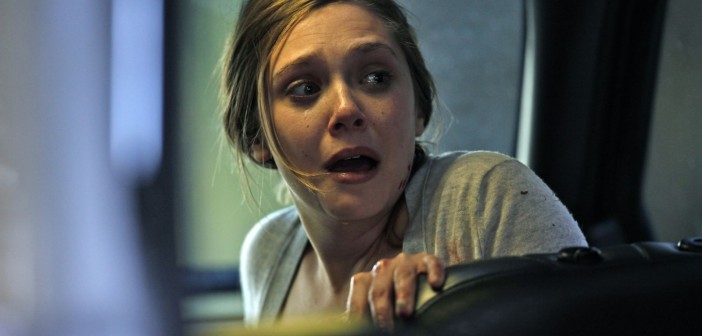Where Memories Surface in Real Time
For the first hour or so if it’s highly publicized eighty-eight minutes, Silent House had me hook, line, and sinker. But then I reached the climactic surprise twist, and something changed. In part, it had to do with not wanting the mystery to be solved; I appreciate a good explanation as much as the next moviegoer, but I also believe that situations are infinitely more frightening when they happen for no apparent reason. Mostly, however, it had to do with characterization and logistics, neither of which made it seem likely that the story could lead to this particular turn of events. I’m not going to say that the filmmakers cheated, since the intention was to make a psychological thriller. I will say that, given what had already transpired, they didn’t try hard enough with the ending.
Having said this, I refuse to forget about the events leading up to the ending. In my humble opinion, the first hour of Silent House represents some truly great horror filmmaking. The big selling point is that it consists of one continuous, uninterrupted shot, allowing the story to unfold in real time. While I initially dismissed this as a shameless marketing gimmick, I realized after ten minutes that it truly does help the film a great deal. It exhibits the same kind of manic, desperate, urgent energy exhibited by a found-footage mockumentary, the only difference being that this film doesn’t actually resort to becoming one. This is good because that style of filmmaking is rapidly wearing out its welcome, in large part because its reach now extends to genres other than horror, where it doesn’t really belong.
It’s a remake of the 2010 Uruguayan film The Silent House, which was said to be inspired by actual events from the 1940s (although this has never been proven as fact). It tells the story of a young woman named Sarah (Elizabeth Olsen), who’s helping her father (Adam Trese) and uncle (Eric Sheffer Stevens) empty out their isolated summer house near a lake. It has fallen into disrepair, it has frequently been vandalized, and squatters are known to occasionally take residence. In short, it’s time to patch the place up and sell it. Just before she goes inside, Sarah is approached and hugged by Sophia (Julia Taylor Ross), who says that they grew up together. Sarah has trouble recalling this young woman, although their conversation is cordial enough that they decide to hang out later that night. “I really do remember you,” Sarah says, trying to save face. “How could you forget?” Sophia says cryptically before pedaling away on a bike.
The film begins in the late afternoon, which means it’s still light out. However, every window in the house, even the ones that weren’t smashed by vandals, is boarded up. The house is engulfed in darkness. Because of this, we don’t get a real sense of proportion or location; Sarah seems perpetually lost in a labyrinthine world of doors, hallways, staircases, and paper-covered walls. She will spend most of the film clutching onto a fluorescent lantern, which casts cold, uninviting light in all the right places. At the same time, many parts of the house are kept hidden from view. This is key – what you don’t see is a hell of a lot scarier than what you do see. Indeed, the scares are so strategically placed that you have to marvel at the crew’s ability to set them up during the film’s one take. When we’re not jumping in our seats, we’re clinging to our armrests in sheer suspense. Let it suffice to say that the title is fitting.
Sarah’s uncle leaves after having a fight with her dad. She claims she heard a noise from upstairs, as if someone was actually up there. Dad goes to check it out. Sarah goes into her room to start throwing things out. A sudden thud comes from another room. She calls for her father. He doesn’t respond. She eventually finds him lying on the floor unconscious, his head wounded. Panicked, she tries to leave the house and get help, only to find that she can’t unlock any of the doors or windows. She then sees a mysterious man stalking the rooms, making those heavy, masculine footsteps. She goes from floor to floor and room to room, alternating between hiding and looking for a way out. All leads to the single most frightening sequence in the film, in which Sarah’s lantern goes out, plunging the entire screen into darkness; she grabs her father’s Polaroid camera and snaps some photos, using the flash setting as a light source.
We’re made to wonder about more than the presence of the stalker. We also get brief glimpses of a little girl in a dress. Who is she, and what is she doing there? What are Polaroids doing scattered throughout the house, and why do Sarah’s father and uncle hurriedly stuff them into their pockets as soon as they find them? And exactly who is Sophia? The answers to all of the above are provided, which is part of the problem. There are some mysteries I don’t want solved, especially in the case of movies like Silent House. There’s genuine terror in the unknown. The other part of the problem is the explanation itself, which I have no intention of passing along to you. It’s not so much that it’s a bad idea; it’s simply that, under the circumstances, aspects of it seem highly implausible. I cannot recommend the first hour of this film highly enough. But when it comes to the final twenty-five minutes, prepare to be somewhat disappointed.

